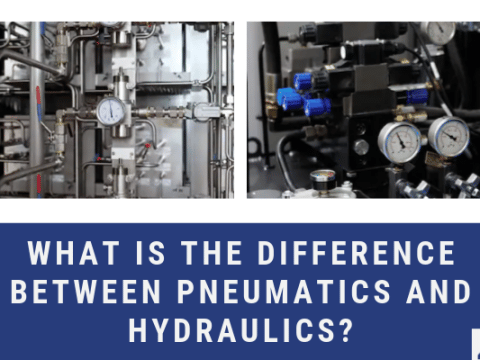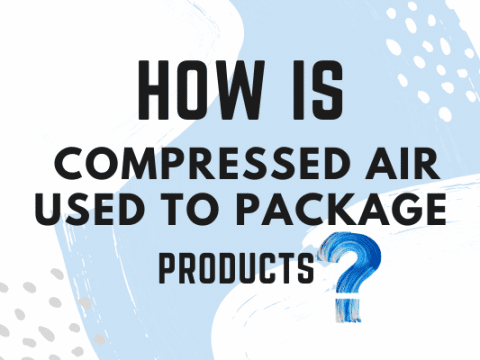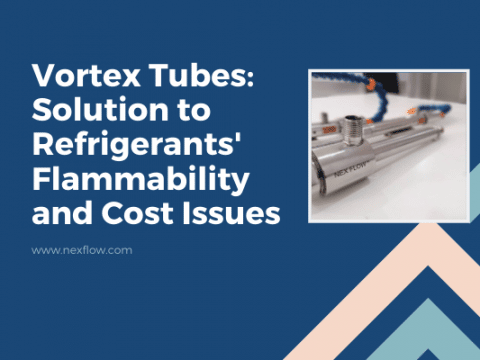
A Ring Vac is a compressed air operated conveyor that works on a Venturi principle. Compressed air is input into the Ring Vac internal plenum chamber and exits from several holes drilled around the inside diameter of the unit in the direction of flow out of the unit creating a vacuum at the inlet end. The holes are designed to minimize compressed air use and optimize the creation of the vacuum. The air flow outlet is amplified approximately 6 times that of the inlet compressed air. Unlike “coanda” profile air operated units called “air amplifiers” the air operated conveyor device create a much higher vacuum and less air flow amplification. For this reason they are excellent for conveying products longer distances. A pipe or tube is connected to each end of the unit. Material is fed into one end and exits at the other. How far vertically and horizontally can the unit convey depends on the physical size of the unit (vacuum decreases as size increases) and the nature (weight, size and shape) of the material conveyed.
As for products to be conveyed they may be small particles, powders, larger materials and even gasses. Venting can be a great application for Ring Vacs especially if the gasses are not clean as will be explained further.
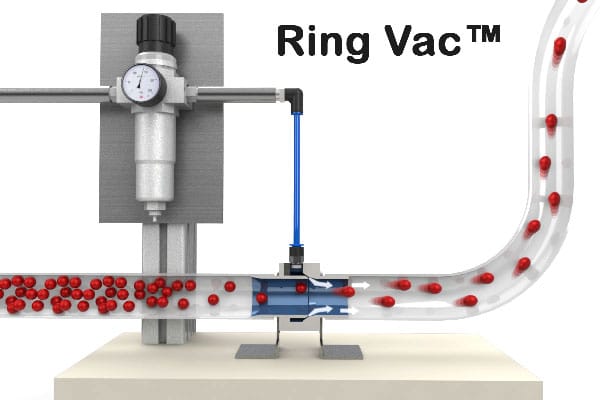
Because these units use compressed air, they are not likely to be used to conveying tons of material. Instead, they are best suited for primarily intermittent applications (or continuous applications where low pressure is needed such as in gas venting) and for capacities limited to under 15 pounds or 7 kg per minute. Within these limits however, Ring Vacs can effectively and economically replace electrically operated vacuum pumps in all sorts of applications and industries. Now, let’s look at its compatibility with different types of materials.
Compatibility with solids: When conveying solid materials, the material in size should be no more than 50% of the size of the inlet diameter of the Ring Vac to avoid getting stuck. An exception is, for example if a long (but thin piece) that will fit through the unit is fed into the Ring Vac. In that case, as with other materials, it will be drawn in and accelerated to a high speed and conveyed along the pipe or tube to which it is connected. Standard Ring vac units are available in anodized aluminum, a more powerful version in hard anodized aluminum to handle more abrasive materials, and in 303/304 stainless steel for corrosive and high temperature applications and in 316L stainless steel for higher corrosive environments and for food and pharmaceutical applications such as in the conveying of capsules and pills. Ring Vacs may be manufactured out of special materials for conveying materials if the standard materials are not compatible.
Conveying powder: Moving powder is easy with a Ring Vac but it’s the powder “exiting the unit that has to be dealt with. The powder leaves at a high velocity and when the powder exits and is collected, a large dust cloud can be created. So whatever container it enters must be deep enough to contain the cloud. Using a fine filter to contain the cloud will not work because the back pressure caused by too fine a filter will negatively affect the conveying performance. In one creative application, a stainless steel Ring Vac was used to convey seasoning from one vat to another to be mixed with other material. The seasoning was fine powder. On the vat where the seasoning was conveyed, the customer installed a “chimney” that was tall enough to contain the cloud created when the material went into the vat. At the top of the chimney was a “coarse” filter which allowed for the air flow to exit but enough to contain the seasoning.

Small Particles: With small particles and also with powder, when the material is collected at the inlet side of the Ring vac (we restate that you need to attach some pipe or tube at the inlet end as well as at the outlet to collect the material for best performance), the material needs to “breathe” to be drawn into to conveyor. So placement of the inlet tube or pipe and design is important. But once inside the unit they are easy to convey.
Large Objects: The main thing to note in conveying larger materials is that the size or dimension of the object should not be greater than 50% of the inside diameter of the Ring Vac to avoid getting stuck. If the materials are smaller than half the inside diameter – even relatively heavy objects such as screws and nails can be conveyed effectively.
Compatibility with Gas: Gas venting is one major application. Air Amplifiers can also be used but there is one major advantage of using Ring Vacs and that is the intrinsic design. When air amplifiers convey gas, if the gas is dirty, material can deposit onto the “coanda” profile and after some time negatively affect performance and even stop working when the buildup of dirt and debris becomes critical. The design of the Ring Vac is such that the chance of dirt depositing over the air exit holes is greatly minimized. Also, when using the unit for venting applications you require very little air pressure to move the gasses, even as low as a few PSIG with some applications using only 1 PSIG if conveying a short distance. It is with materials that one has to be careful in moving gasses. Some gasses may be highly corrosive, and sometimes you end up dealing with very high temperatures. For example, high temperature stainless steel units are used to vent hot sour gas and sometimes must handle up to 1200 oF. (649 oC). Special ones made of Teflon have replaced vacuum pumps in scrubbers and use very low input pressure to operate, eliminated high maintenance costs associated with electrically operated vacuum pumps for the same application. Special flanged versions with different materials have been made for many venting and gas conveying applications in a variety of manufacturing such as battery production.
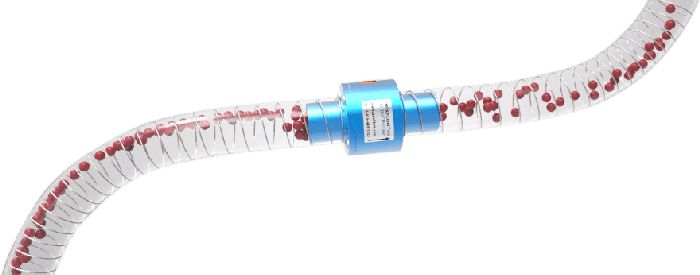
Compatibility with Liquid: Ring Vacs have been used with limited success in liquid conveying and the smaller sizes may be used. They are not really designed for liquid handling and not an application that is encouraged. However, for the smaller sizes (1” and smaller) and for limited distances, they have, and are being used.
Summary: Whether Ring vac are used for conveying solid material, large or small, or powders or for venting gasses, they are economical for smaller capacities outlined above and especially ideal for intermittent applications in the case of solids, or low pressure applications in the case of venting. Like nozzles, air knives or any other compressed air accessories they are virtually maintenance free with no moving parts. They can be made out of a variety of materials, special sizes and shapes have been designed and manufactured for all types of industries – plastics industry for hopper loading, natural gas transmission for venting compressors, semiconductor industry for gas venting, food industry for conveying ingredients, etc. In every case the more costly alternative was vacuum pumps. It would be good to check your operation as to where vacuum pumps are now used to evaluate whether a Ring vac can provide a lower cost, more efficient, alternative.



